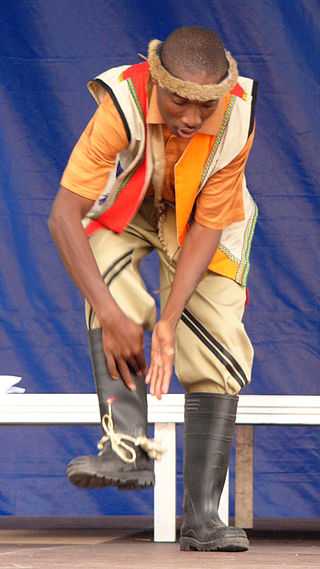Gumboot dance


The gumboot dance (or Isicathulo[1]) is an African dance that is performed by dancers wearing wellington boots. In South Africa these are more commonly called gumboots.
The boots may be embellished with bells, so that they ring as the dancers stamp on the ground. This sound would be a code or a different calling to say something to another person a short distance away. It was basically used to communicate in the mines as there was strictly no talking otherwise they would get punished by their boss.
Origin
Gumboot dancing was conceived by black miners in South Africa as an alternative to drumming—which authorities restricted. Another reason for gumboot dancing was for the miners in South Africa as they worked they sang. Gumboot dancing has now become a world-known dance; in schools children perform the dance.[2] The boots were a solution to a problem of often flooded gold mines in which men otherwise stood in knee-deep water toiling at their work stations.[3] It is also thought that the workers used the gumboots to relay messages to each other that they did not want their bosses to overhear.
Description
Gumboot dancers are commonly sighted on the streets and plazas of tourist areas in South Africa, such as the Victoria & Alfred Waterfront in Cape Town. It is still used today by some miners. The dance likely originated among South African gold miners,[4] and especially in their tough working conditions—including poor lighting and dampness. Many of the steps and routines are parodies of the officers and guards who controlled the mines and workers' barracks.[citation needed] Like other forms of African dance, Gumboot utilizes the concepts of polyrhythm and total body articulation, drawing from the cultural dances of the African workers that manned the mines.[5] It is a percussive dance made by idiophones or autophones (objects of the everyday life vibrating by themselves), and is similar in execution and style to forms of "Stepping" done by African-American fraternities and sororities.
Appearances outside of core context
The dance is the highlight of the performance of Black Umfolosi, a prominent Zimbabwean folk group.[6]
The album Graceland by the American pop singer Paul Simon has a song titled "Gumboots", which is performed in the style of South African township jive (mbaqanga) and contains performances by members of the Boyoyo Boys.
The British-American composer David Bruce has written a clarinet quintet entitled "Gumboots",[7] which was inspired by Gumboot dancing. It was commissioned by Carnegie Hall in 2008 and can be heard in full on their website,[8] performed by Todd Palmer and the St. Lawrence String Quartet.
Since the 1990s and 2000s, Drakensberg Boys' Choir School based at gumboot dancing the folk-African part of their repertoire and white gumboots are the part of the second variant of their concert costume (the first variant is a classical "white man's" costume).
External links
| Wikimedia Commons has media related to Gumboot dance. |
- Lesole's Dance Project - South African Gumboots (example of dancers with bells on their gumboots)
- Otoplasma.com
References
- ↑ http://kilby.sac.on.ca/activitiesclubs/outreach/malawi/isicathulo.htm
- ↑ Post-colonial drama: theory, practice, politics; by Helen Gilbert, Joanne Tompkins; Psychology Press, 1986; "The history of gumboot dancing in South Africa is similar: conceived by black miners as an alternative to the drumming that the authorities restricted, it used available objects such as gumboots, tin cans, and bottletops."
- ↑ Project Malawi; "The floors of the mines were often flooded, with poor or non-existent drainage. For the miners, hours of standing up to their knees in infected waters brought on skin ulcers, foot problems and consequent lost work time. The bosses discovered that providing gumboots (Wellington boots) to the workers was cheaper than attempting to drain the mines. This created the miners uniform, consisting of heavy black Wellington boots, jeans, bare chest and bandannas to absorb eye-stinging sweat."
- ↑ Norris, Michele. "Step Afrika." All Things Considered. NPR (November 28, 2003)
- ↑ African Dance. Kariamu Welsh 2004 Chelsea House Publishers pages 28 ISBN 07910764155
- ↑ YouTube video of Black Umfolosi
- ↑ davidbruce.net
- ↑ Carnegiehall.org